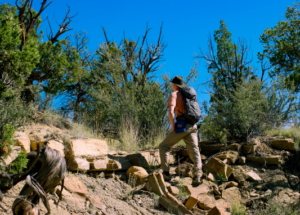Authors: Leo Kuhl, Brian Hampton, Dori Contreras
2024 Geological Survey of America Annual Conference
Date: September 23, 2024
Abstract: The Crevasse Canyon Formation in west-central New Mexico (at the Reynolds Field Station located north of the Sawtooth Mountains) outcrops along the southeasternmost margin of the Colorado Plateau and is thought to record fluvial-deltaic sedimentation along the Seboyeta embayment during the Late Cretaceous (Coniacian-Santonian time). Although this stratigraphic interval has received a considerable amount of study throughout parts of northwestern New Mexico and the Southwestern U.S., very little is known about the depositional history provenance of these strata in west-central New Mexico. Throughout much of the New Mexico, the Crevasse Canyon Formation has been documented to represent nonmarine, fluvial sedimentation and marks the stratigraphic transition from marine sedimentation to nonmarine sedimentation in the Cordilleran foreland basin.
New measured stratigraphic sections, paleocurrent indicators, modal composition trends, and U-Pb detrital zircon data from the lower parts of the Crevasse Canyon reveal a depositional system characterized by (1) isolated, cross-stratified channel sands encased in floodplain strata that contains fossilized leaves, stumps, woody debris, and charcolithified organic material, and (2) laterally extensive sandstone bodies that appear largely massive with isolated, faint cross stratification. Paleocurrent indicators from sandstone units display a wide range of flow directions that include northeast, east, and southeast directed paleoflow. Sandstone modes from these strata reveal high relative abundances of quartz (primarily monocrystalline), feldspar (plagioclase and K-Spar), and a range of lithic fragments dominated by volcanic and metamorphic lithic clasts. Detrital zircon results are compared here with previous work on the Crevasse Canyon from parts of southern New Mexico where the unit contains (1) Precambrian zircons that overlap with the Yavapai, Mazatzal, and Granite-Rhyolite, and Grenville provinces, (2) recycled Neoproterozoic and Early Paleozoic detritus from Mesozoic eolianites of the southwestern U.S., (3) Permian to Triassic zircons that overall in age with granitoid rocks in parts of California and Arizona, and Jurassic-Cretaceous detritus that overlaps with the mid-Mesozoic Cordilleran magmatic arc and Sierra Nevada batholith.
RFS Notes: Leo Kuhl’s research work was the first Masters project completed about RFS geology. He successfully defended his thesis on October 13, 2025 and is scheduled to go to work for Exxon-Mobil. We are so proud of you Leo!!






